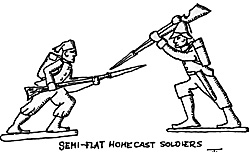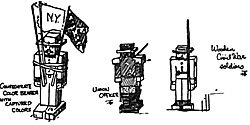
The earliest written accounts of wargamerie in the "archives" date from circa 1952. However, the diligent researcher has managed to recall a number of earlier games which may strike a nostalgic spark from other members of the ancient and honorable company of war gamers.
In 1936 T.J.H. was hospitalized when a scarlet fever epidemic swept the town. Recovery w4s slow in those pre-perticillin days and a form of war game developed during the long days in the hospital, This was a simple game. The troops were cut from paper and stood about two inches tall. By bending the shoes forward and the side tabs to the rear they would stand. The troops were deployed in the aisle, about twenty feet between the rival forces. Marbles were rolled -sometimes "at will" and sometimes by turns-down the long aisle of the ward between the beds. There was one "enemy" unit of grenadiers cut, not from old envelopes, but from heavy cardboard lotto cards, that was wonderfully durable under fire. Casualties were determined by whether they fell "face up". wounded; "face down", dead; or "on the side" which was a scratch and they were stood up again if they survived until the end of the turn of fire.
A few years later the game used home-cast semi-flats made of scrap lead and while marbles were still used, a primitive hand-to-hand action developed. The soldiers were moved, roughly, five base lengths and if able to stab an enemy (while the other player was scrambling for marbles in the corners was a good time) he got him! The mold we used the most had a Turk or zouave type with up thrusting bayonet and he was opposed by an overhead down stabbing type that we always thought of as "Anzacs" though the pith helmet could hve been any sort of colonial type. I have often wondered how the mold was described in the catalogues. Arguments came often and in the words of H. G Wells "It was a game crying aloud for improvement."
The next phase of war gaming came in the early '40's following a trip to the battle field of Gettysburg in 1939. Lead was too expensive for the large units we envisioned. The cheapest "store-bought" soldiers were a dime at Woolworth's. Wooden soldiers, jig-sawed from melon crates and painted with enamel, were the answer. Since a toothpick was just the right length for a bayoneted musket, they must have been about 2 1/4" tall for infantry and artillerymen.
Our train table was converted to norther Virginia and we refought many battles of the Civil War, drawing heavily on Campfires and Battlefields. Again, we developed our own rules. We had read of H.G. Wells' Little Wars in one of Neeley Hall's books, but though I hopefully visited every library within reach I never found a copy on the shelves. (Not until I was back from the real wars, through college and more affluent-about 1952 it was-did I have the luck to acquire a copy of the war gainer's classic.)
The rolling marble and rubber band sniper rifle gave way to shooting cannon (home-made with rubber bands to shoot marbles, matches, and cotton swabs) Here the wooden soldier veteran was superior to the fabulously expensive Britains. He fell, only to rise again good as new without dents and broken heads. The rules included measured moves and a "battle" system in which we counted cavalry 2, infantry 1, captains 2, Generals 3, The greatest number won.
The loser lost 1/4 of his points dead, 1/4 wounded, 1/4 prisoners; the winner lost 1/4 dead, 1/4 wounded, held the position and captured any colors the loser had. Regimental flags were fastened on toothpicks and cunningly "held" with a rubber band. Captured colors could be carried the same way. Regiments were a captain, lieutenant, and 8 enlisted men. Toward the end of a game (long before the Grant 50% rule) some "provisional units" were more than half officers. Perhaps these units of 2-pointers foreshadowed the "guard battalions" of later years. We negotiated prisoner exchanges and some games ran on for several weeks.
The game provided definite objectives rather than a fight-to-a-finish
ending. Each side had a capital sector and two towns. In addition to points for
capturing towns, points were given at scoring time for each "enemy" sector
occupied. Outnumbered soldiers in a given sector, surrendered as I remember.
This gave the cavalry a real function in the closing stages of the game as they
galloped madly to overrun as much
enemy territory as possible, or fight off raiders. One of the veteran mounted units
(I hesitate to call them real cavalry) were Captain Jenk's Horse Marines. They were
homecast with shakos, bell bottomed trousers, striped stockings and bell-mouthed
musketoons. Though they were mounted on dime-store mules they accumulated a
noble and very effective record in Washtenaw Campaigns.
 T.J.H. and friends J.M., T.W. and others used a 4'x4' masonite board
with roads, swamps, and forests colored in crayon. Larger wooden hills were added
for variety and houses, barns, chicken coops, and piggeries were quickly and
cheaply constructed of folded construction paper. (Harry G. Dowdall and Joseph H.
Gleason Sham-Battle [New York: Alfred A Knopf Inc.] 1929).
T.J.H. and friends J.M., T.W. and others used a 4'x4' masonite board
with roads, swamps, and forests colored in crayon. Larger wooden hills were added
for variety and houses, barns, chicken coops, and piggeries were quickly and
cheaply constructed of folded construction paper. (Harry G. Dowdall and Joseph H.
Gleason Sham-Battle [New York: Alfred A Knopf Inc.] 1929).
A feature that added to the excitement was the system of timed moves. (See also Little Wars) The game provided for five-minute moves in which you had to first move and then fire as many as possible before the timer bell rang. A system of bonus cards gave a card for each unused minute. These represented extra moves and artillery shots. When the players were 'mature enough to resist moving troops in groups, or by the handful with the resulting wear and tear to the uniforms, it was the perfect answer to the chess-like tedium which can grip and strangle an otherwise delightful game. It also provided an opportunity (against a talkative or otherwise unwary opponent) to ask an apparently innocuous question that would siphon off a minute or so of his moving time. This often resulted in saving your own troops from a hail of musketry should they be caught in an exposed position.
Following a return to civilian life in 1946, T.J.H. war game activities were confined to a variety of board games-who remembers Tactics, a naval game by Parker Bros? Strategy, by Corey Game Co? and one of the best of all strategy games-Japanese GO? (When I was in the service at Fort Riley we carried a sock full of GO pieces, a folding board made of oil cloth and played it four-handed on breaks and during the slow spots of field work) We had a spin-off from that that we called "Infiltactics".
Finally in 1951 the first authenticated documents appear in the "Archives". These include the "Washtenaw Campaigns" (54mm figures using the "Asbury or Old rules" and the "Wells' Rules"). the "Scrubean Accounts" (covering the shift into 30mm troops) and the now famous and nostalgic "Bluvian Chronicles".
In 1951 T.J.H. obtained a mimeographed set of rules published in Asbury Park. These rules reflect (as concluded after diligent, scholarly research) some effect of influence by the book Sham-Battle by Harry Dowdall and Joseph Gleason in 1929. The Asbury rules used 54mm figures on a board 3x5' ruled into 1" squares and 6" square sectors.
These rules were the result of seven years of wargaming and produced a balanced cohesive game. The soldiers moved and fired and fought as individuals. It was an alternate move game. The players moved, fired cannon, fired muskets, and finally hand-to-hand combats. Eight man infantry, fivernan cavalry usints were standard (by coincidence, you will realize as an attentive reader, the traditional numbers of the Britains sets. Musketry fired at long range-4" to 6" with one dice, short range 2" to 3" with 2 dice and a one was a hit. Hand-to-hand combat used a two dice and 2, 2 were hits. An additional green dice gave 1,2,3=wounded (field hospitals were used as outlined in Sham-Battle) and 4,5,6 were dead.
Back to The Armchair General Vol. 1 No. 5 Table of Contents
Back to The Armchair General List of Issues
Back to MagWeb Master Magazine List
© Copyright 1999 by Pat Condray
This article appears in MagWeb (Magazine Web) on the Internet World Wide Web. Other military history articles and gaming articles are available at http://www.magweb.com
